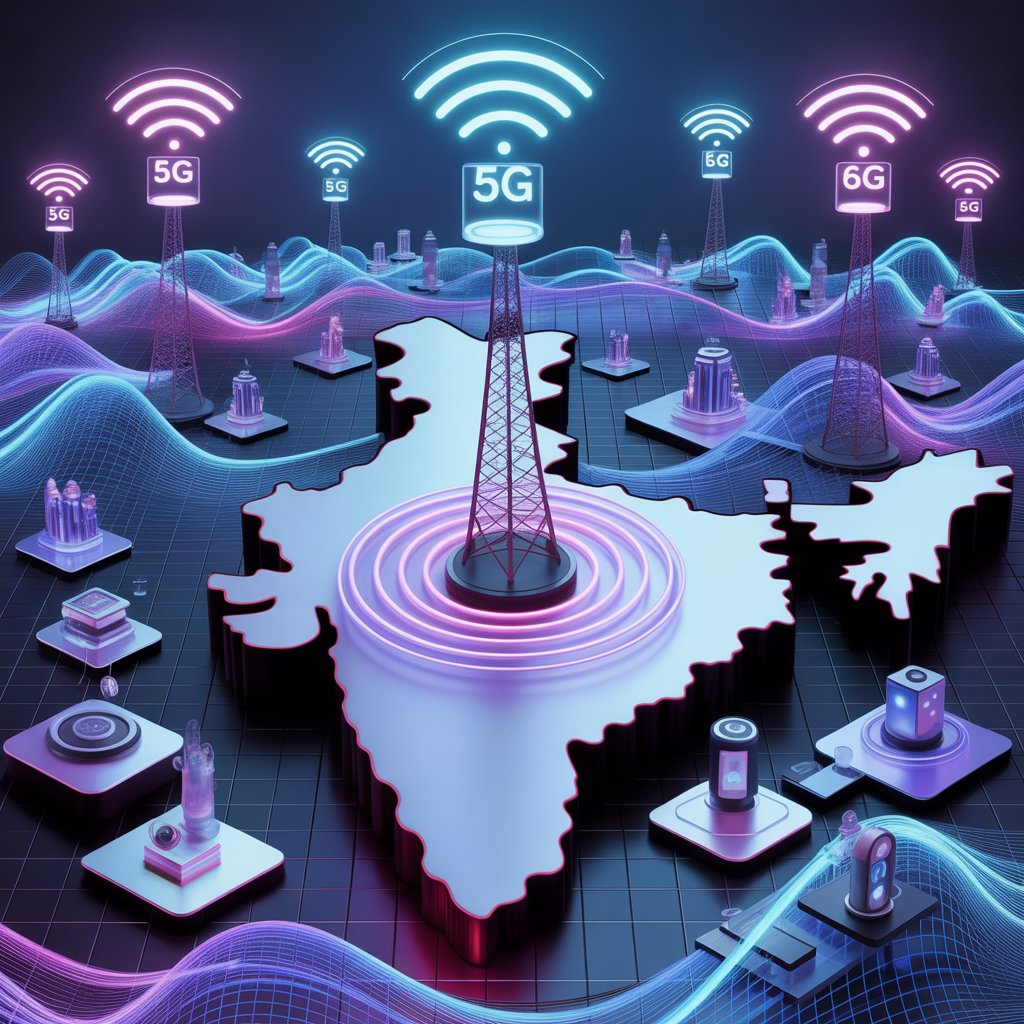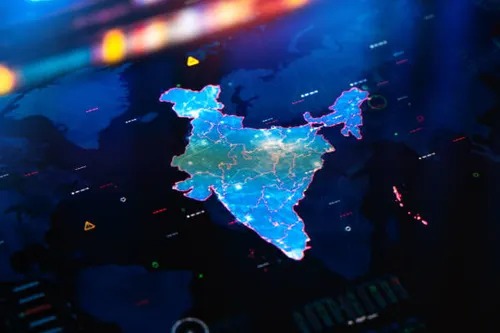

Remember the buzz when 5G finally hit Indian shores? The promise of lightning-fast downloads, lag-free gaming, and revolutionary new services felt like science fiction becoming reality. But even as we’re still unpacking the full potential of 5G, the tech world is already whispering – and increasingly shouting – about its successor: 6G. As a nation on a relentless digital transformation journey, India stands at a fascinating crossroads. So, what does this next leap mean for us? Buckle up as we dive deep into 5G vs 6G, exploring where we are, where we’re headed, and what India can realistically expect from the next generation of wireless magic.
Setting the Stage: India’s Digital Ambition Meets Next-Gen Connectivity
India’s 5G rollout, spearheaded by major telecom operators like Reliance Jio, Airtel, and Vodafone Idea, has been one of the fastest globally. From bustling metros to emerging Tier 2 and 3 cities, the footprint is expanding, bringing tangible changes – smoother video calls, faster app downloads, and the first glimpses of IoT (Internet of Things) applications. But India’s ambitions are grander. Initiatives like Digital India, Smart Cities Mission, and the push for Industry 4.0 demand more than just speed; they require a fundamental shift in how we connect, compute, and interact with the world.
Enter 6G. While still largely in the research and standardization phase globally (with bodies like the ITU and 3GPP laying the groundwork), 6G isn’t just an incremental upgrade. It promises to be a paradigm shift, moving beyond connecting people and things to seamlessly integrating the physical, digital, and biological worlds. For India, a nation grappling with unique challenges of scale, diversity, and the digital divide, the transition from 5G to 6G is laden with immense potential and significant hurdles
5G Today: The Foundation India is Building Upon
Before we leap to 6G, let’s ground ourselves in what 5G actually delivers and where India stands:
- Enhanced Mobile Broadband (eMBB): This is the most visible benefit – significantly faster speeds (potentially 10-100x faster than 4G) and massive capacity. Think ultra-HD video streaming, immersive AR/VR experiences, and near-instant cloud access. Indian users are already experiencing this in covered areas.
- Ultra-Reliable Low Latency Communications (URLLC): This is crucial for applications where split-second response times are critical. Imagine remote surgery performed by a surgeon miles away, real-time control of industrial robots, or vehicle-to-vehicle communication for safer autonomous driving. While early pilots exist in India, widespread URLLC deployment is still evolving.
- Massive Machine Type Communications (mMTC): This enables connecting a vast number of low-power devices – sensors, meters, wearables – forming the backbone of smart cities and Industrial IoT (IIoT). Think smart meters optimizing energy use in Mumbai or agricultural sensors monitoring soil moisture in Punjab.
4. Network Slicing: 5G allows operators to create multiple virtual “slices” of the network, each optimized for specific needs (e.g., one slice for high-speed internet, another for ultra-reliable industrial control). This flexibility is key for diverse Indian use cases
India’s 5G Journey So Far
Rapid Rollout: Aggressive deployment by operators, covering major urban centers and expanding rapidly.
Use Case Exploration: Early pilots in manufacturing (predictive maintenance), healthcare (remote diagnostics), education (AR/VR learning), and agriculture.
Affordability Challenge: Ensuring 5G devices and plans are accessible across socio-economic segments remains critical for true inclusivity.
Infrastructure Hurdles: Fiber backhaul deployment, power availability for small cells, and right-of-way issues are ongoing challenges, especially in dense urban areas and rural locations.
5G’s Impact (Tangible & Emerging):
- Consumer: Faster downloads, smoother streaming, enhanced mobile gaming.
- Enterprise: Improved logistics, remote asset monitoring, augmented workforce productivity.
- Society: Foundations for smart infrastructure, potential for telemedicine expansion, smarter agriculture techniques.
6G Tomorrow: Beyond Speed, Towards Sensory & Intelligent Networks
While 5G is still maturing, the vision for 6G (expected around 2030) is truly transformative. It aims to transcend the limitations of 5G, creating a fabric of connectivity that feels almost invisible yet omnipresent:
- Extreme Performance: Think peak data rates potentially 100 times faster than 5G (approaching terabits per second), latency reduced to mere microseconds (approaching human neural speed), and near-perfect reliability. This enables previously impossible applications.
2. Integrated Sensing & Communication: This is a game-changer. 6G networks won’t just carry data; they’ll sense the environment. Using advanced radio waves (potentially in the terahertz (THz) spectrum), they could detect objects, measure distances, monitor health vitals, and map surroundings with incredible precision. Imagine your phone detecting air quality or your car sensing pedestrians around corners via the network itself
- Ubiquitous Connectivity: 6G aims for truly global coverage, integrating satellite networks (Low Earth Orbit – LEO, Medium Earth Orbit – MEO), high-altitude platforms (HAPS), and terrestrial networks seamlessly. This promises to finally bridge the digital divide, bringing high-speed connectivity to the most remote villages in India and the deepest oceans.
- Native AI Integration: Artificial Intelligence won’t just run on the 6G network; it will be deeply embedded within it. Networks will be self-optimizing, self-healing, and capable of intelligently allocating resources based on real-time needs and predictive analytics.
- Holographic Communications & Multisensory XR: Forget flat video calls. 6G could enable lifelike, real-time holographic telepresence and truly immersive Extended Reality (XR) experiences that engage multiple senses (touch, even smell) seamlessly. Revolutionizing remote work, education, and entertainment.
- Sustainability Focus: Energy efficiency will be paramount. 6G aims to be vastly more energy-efficient per bit transmitted than 5G, crucial for India’s climate goals and operational costs.

| Feature | 5G (Where India Is Now) | 6G (India’s Potential Future) | Impact for India |
| Peak Speed | 1-10 Gbps (Real-world often lower initially) | 100 Gbps – 1 Tbps+ | Instant access to massive datasets, complex XR |
| Latency | 1-10 milliseconds | Sub-1 millisecond (Microseconds) | Real-time remote control, tactile internet |
| Connectivity | Millions of devices per sq km | Trillions of devices per sq km | Massive IoT scale for smart everything |
| Key Tech | mmWave, Sub-6 GHz, Network Slicing, MIMO | THz Frequencies, AI-Native, Integrated Sensing, Advanced MIMO, LEO Satellites | New capabilities (sensing), ubiquitous coverage |
| Core Focus | Connecting People & Things | Integrating Physical, Digital & Biological Worlds | Holistic solutions for society & industry |
What India Can Expect from the 6G Era: Predictions & Possibilities
The transition to 6G won’t be an overnight switch. It will be a gradual evolution, building upon the 5G foundation. Here’s what India can realistically anticipate: Expect serious 6G research and development to intensify globally and in India over the next 2-3 years. Initial 6G standards might emerge around 2027-2028. Commercial rollout in India is unlikely before 2030-2032, coinciding with global timelines. This gives India crucial time to solidify its 5G ecosystem and prepare the ground
India’s 6G Initiatives: India isn’t just waiting. The Bharat 6G Vision document, released in 2023, outlines an ambitious roadmap. The Bharat 6G Alliance (B6GA), a collaborative platform involving industry, academia, and government (including the Telecom Technology Development Fund – TTDF), is actively fostering indigenous R&D. Expect significant investment in testbeds, talent development, and IP creation
Transformative Applications for India:
Imagine remote surgery with near-zero latency haptic feedback, real-time continuous health monitoring via network-integrated sensors, and AI-powered diagnostics accessible in rural clinics via holographic consultations. 6G could democratize access to specialist care nationwide.
Ubiquitous sensors powered by 6G and integrated satellite connectivity could provide real-time, hyper-local data on soil health, moisture, pests, and crop conditions across vast Indian farmlands. AI analysis could offer precise irrigation, fertilization, and harvesting instructions, boosting yield and sustainability.
Beyond traffic management, 6G’s sensing capabilities could monitor structural health of bridges and buildings in real-time, optimize energy grids dynamically, manage waste collection hyper-efficiently, and enable truly responsive public safety systems. Digital twins of entire cities could be used for simulation and planning.
Factories with thousands of wirelessly connected robots and sensors, communicating and coordinating in microseconds. Real-time AI optimization of entire production lines, predictive maintenance eliminating downtime, and seamless human-robot collaboration. Make in India could get a massive tech boost.
Holographic teachers could beam into remote classrooms. Students could virtually explore historical sites or complex biological processes in immersive, multisensory XR. Vocational training could involve realistic simulations of complex machinery or procedures.
The integration of LEO satellites and HAPS with 6G terrestrial networks holds the promise of finally delivering affordable, high-speed broadband to India’s most remote villages, enabling access to education, healthcare, government services, and economic opportunities.
Real-time sensing could detect natural disasters faster. Seamless communication between first responders, drones, and command centers even when terrestrial networks are damaged (using non-terrestrial networks). Accurate situational awareness during crises

Challenges India Must Address:
Spectrum Availability & Cost: Accessing the high-frequency THz bands needed for 6G’s peak performance and sensing requires significant regulatory planning and investment. Affordability remains key.
Massive Infrastructure Investment: Deploying dense networks of small cells (especially for THz), integrating satellite backhaul, and ensuring ubiquitous fiber optic backhaul will require enormous capital expenditure. Public-Private Partnerships (PPPs) will be crucial.
Developing Indigenous Tech: Reducing reliance on foreign vendors for core 6G technologies (chips, equipment) is vital for security and economic growth. Success depends on sustained R&D funding and industry-academia collaboration.
Cybersecurity & Privacy: With networks sensing the physical world and integrating deeply with AI, the attack surface and privacy concerns explode. Robust, homegrown cybersecurity frameworks and data protection laws are non-negotiable.
Skilling the Workforce: Preparing engineers, technicians, and professionals for designing, deploying, maintaining, and utilizing 6G technologies requires a massive skilling initiative.
Device Affordability: Ensuring 6G-capable devices are accessible to the masses will be critical for inclusive adoption.
Conclusion: Navigating the Wave – From 5G Foundations to 6G Horizons
The journey from 5G to 6G is not a race to replace, but an evolution to transcend. 5G in India is laying the essential groundwork – the high-speed pipes, the network intelligence, and the initial ecosystem of applications. It’s solving today’s problems of speed and scale, enabling the first wave of smart city initiatives and industrial automation.
6G, however, promises to redefine the very nature of connectivity. It’s about creating a sensory, intelligent, and truly ubiquitous network fabric. For India, the potential is staggering: bridging the digital divide once and for all, revolutionizing critical sectors like healthcare and agriculture, propelling Industry 4.0, and building hyper-efficient, responsive smart cities.
